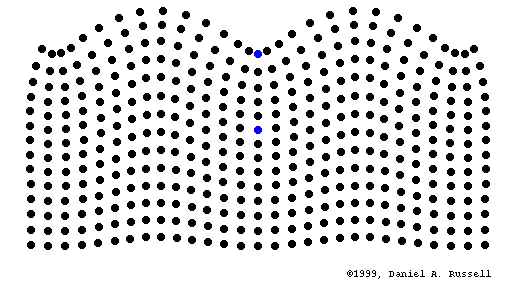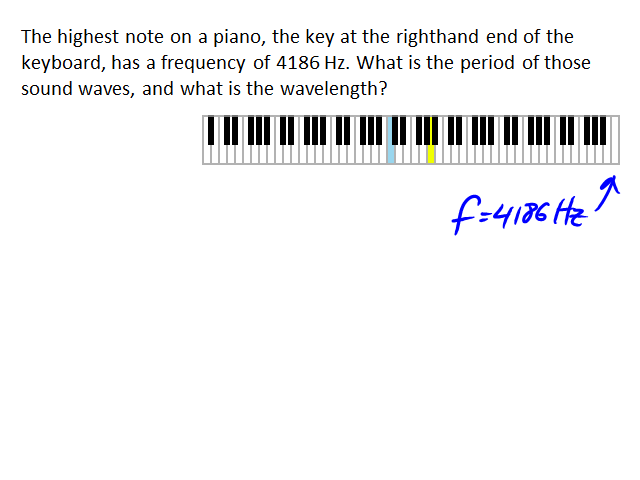What Waves Are
What are waves? Waves are traveling (propagating) disturbances or vibrations. They carry energy. The stuff they are vibrating in is called the medium. The direction a wave is moving is called the direction of propagation.
Types of Waves
There are three basic kinds of waves...
TRANSVERSE WAVES are waves where the vibrations are perpendicular to
the direction of propagation. (Transverse is a fancy word for perpendicular.)
Here's a drawing of such a wave, propagating to the right on the page,
with velocity v. The peaks and valleys of the waves are called crests and troughs, respectively. The distance from one crest to the next
crest is called the wavelength. The symbol for wavelength is the greek
letter lambda, l. The height of the crest
above the centerline is the amplitude of the wave, A.

Light (a.k.a. electromagnetic radiation) is a transverse wave. Green light, for example, has a wavelength of about 500 nanometers. Different colors are different because they have different wavelengths. Radio waves, infrared, visible light, ultraviolet, x-rays and gamma rays are all electromagnetic radiation. In a vacuum these all move at the same speed, 3.00x108m/sec. Really fast!
LONGITUDINAL WAVES are waves where the vibrations are parallel to
the direction of propagation. Here's a drawing of such a wave. Again,
it's propagating to the right. Where the vibration causes the particles
to be bunched together, that's a compression. Where
they are farthest apart is a rarefaction.

Sound is a longitudinal wave. In air, it travels at around 340 m/sec, although this varies a little depending on the barometric pressure and temperature.
TROCHOIDAL WAVES are kind of like a combination of
longitudinal and transverse waves. The vibrations are circular because
they occur both parallel and perpendicular to the direction of propagation.
They look like transverse waves, though.

Surface waves on the ocean (or a pond or in a cup of water, etc.) are trochoidal waves.Here's a short video showing the circular motion that is characteristic of trochoidal waves.
VERY IMPORTANT FACT: the things that are vibrating (air molecules in sound; water molecules in ocean waves) only move a tiny distance. It's the disturbance that travels long distances. To convince yourself this is true, look at the animated gifs above. In each, pick one particular dot and follow it carefully. You'll see it moves, but only a little bit, in a repetitive cycle.
Activities To Do As You Read
1. Here is a link to a simulation of a wave on a string. http://phet.colorado.edu/simulations/ stringwave/stringWave.swf. What kind of wave is it? Play with the variations: how much damping (friction) there is, Manual vs. Oscillate, Frequency, and Fixed, Loose or No Ends.
2. Here's another simulation that includes all three kinds of waves trochoidal (water ripples), longitudinal (sound) and transverse (light). Experiment. Here are some things to try: (a) When viewing the water waves, use the Rotate slider (to the right) to get a sideways view. (b) When viewing the sound waves, turn on your computer's speaker with the Audio checkbox on the right.
3. Use either or both of the simulations above to answer these questions:
(a) Does the speed of the waves change if you change the frequency?
(b) When you increase the frequency, what happens to the wavelength?
Mathematical Relationships Between Speed, Wavelength, Frequency and Period
The frequency of a wave is how many vibrations pass you per unit time. It is measured in the unit "cycles per second", where the word "cycle" is just another name for "vibration". Sometimes you'll see it abbreviated cps, but usually it's called a Hertz, abbreviated Hz. If the frequency is how many vibrations per second there are, then the inverse would be how many seconds per vibration — that is, how much time it takes for one vibration. This is called the period, T. Written as an equation, we have
![]()
![]()
The relationship between velocity, wavelength and frequency is

Some things that happen to waves, which we'll be studying later: diffraction, interference, reflection, refraction, and the Doppler Effect.
An Example Calculation
EXAMPLE: The highest note on a piano, the key at the righthand end of the keyboard, has a frequency of 4186 Hz. What is the period of those sound waves, and what is the wavelength? SOLUTION VIDEO
Additional Activities & Practice
NOTE: for some of these questions you'll need to know the speed of the waves. Remember the speed of sound in air is about 340 m/sec, and light and other electromagnetic waves travel at 3.00x108 m/sec.
4. A kid on a swing at the playground swings back-and-forth once every
3 seconds. What is the frequency and period of the swinging?
5. Different colors of light have different wavelengths and frequencies.
The reddest red has a wavelength of about 700 nm. The most violet violet has a
wavelength
of about 400 nm. All the other colors are in between. What are the frequency and
period of these two colors?
6. The radio station WHFS broadcasts at a frequency of 99.1 MHz. What is the wavelength of that electromagnetic wave?
7. How much time would it take a radio wave (which is an electromagnetic wave)
to travel all the way around the Earth (assuming it went in a circle)?
8. Let's say a lightning bolt strikes the ground one mile away from you. (a)
How long will it take the light flash to reach you? (b) How much time will
it take for the sound (thunder) to reach you?
9. Young humans can hear a range of sound frequencies from about 20 Hz to 20,000
Hz. What is the range of wavelengths and wave periods young humans can hear?
10. Measure the wavelength and amplitude of these two waves. If they both have
a frequency of 30 Hz, how fast are they moving?
(a)  (b)
(b) ![]()
11. You are running. If you take three steps per second, and each step
is 70 cm long, how fast are you moving?
12. SPREADSHEET: Create a spreadsheet with two input cells (velocity and frequency) and two output cells (wavelength and period). Use it to doublecheck your answers to problems 6 and 9, above.
Check your answers.




